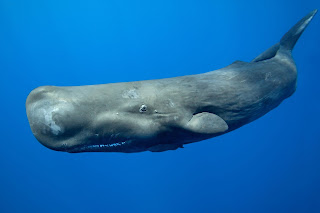
The sperm whale is the largest of the toothed whales. Sperm whales can be found in all of the world’s oceans. The sperm whale population is divided into groups that live in the north and south hemispheres. Males are more frequently seen near the polar regions than females, who spend the majority of their time with young whales in temperate waters. Sperm whales are listed as an endangered species due to extensive hunting in the past.
Sperm whales are large mammals that can grow to be 49 to 50 feet long and weigh between 35 and 45 tons. Males are physically larger than females.
Sperm whales have wrinkled skin that is bluish-gray or light brown. Their large, squared head accounts for one-third of their overall body size.
Sperm whales were named after the spermaceti organ found in their heads. This organ produces a large amount of waxy substance (oil) that regulates the buoyancy of the whale.
The sperm whale, unlike other whales, has a single blowhole on the left side of the head. Condensed air is blown forward and under the angle, assisting in identifying the sperm whale from a distance.
In their tiny lower jaw, sperm whales have 18 to 30 conical teeth.
Giant squids make up 80 percent of the sperm whale’s diet. Battles between these two massive creatures frequently result in large scars on sperm whales. Sperm whales eat fish, octopus, shrimp, crabs, and sharks that live at the ocean’s bottom in addition to giant squids.
Sperm whales can dive to depths of over 3000 feet while hunting giant squids.
A sperm whale can stay underwater for 90 minutes without returning to the surface to breathe.
Sperm whales can swim at speeds of up to 23 miles per hour.
Sperm whales have small eyes and poor vision. However, thanks to echolocation, even blind whales can find food. This method entails making clicks and listening to the resulting sounds (after bouncing off the objects in front of them). Sperm whales can detect prey without using their eyes by using echolocation.
Sperm whales congregate in groups known as pods. They are made up of sexually mature females and their children.
Except during mating season, males are usually solitary.
Mating season occurs during the summer. The male joins the female pod and mates with all sexually mature individuals.
Pregnancy lasts 14 to 16 months and results in a single child. The mother looks after the baby for the first two years of its life.
The sexual maturity of sperm whales is determined by their size. Females can become pregnant as soon as they reach 28 feet in length. Males are ready to mate when they reach 39 feet in length.
Sperm whales live in the wild for 50 to 70 years.








